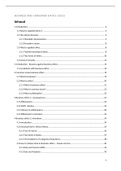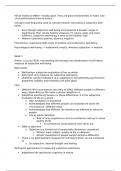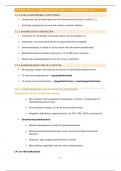Inhoud
1 Introduction.........................................................................................................................................3
1.1 What is (applied) ethics?..............................................................................................................3
1.2 The ethical demand......................................................................................................................5
1.2.1 Threefold characteristics.......................................................................................................5
1.2.2 Disruptive nature...................................................................................................................8
1.3 What is applied ethics...................................................................................................................8
1.3.1 Twofold meaning of ethos.....................................................................................................8
1.3.2 Two forms of ethics.............................................................................................................10
1.4 General remarks.........................................................................................................................12
1 Introduction - Reasons against business ethics.................................................................................15
1.1 6 problems with business ethics.................................................................................................16
2 Common sense business ethics.........................................................................................................19
2.1 What is business?.......................................................................................................................19
2.2 What is ethics?............................................................................................................................20
2.2.1 What is business ethics?......................................................................................................21
2.2.2 What is common sense?......................................................................................................22
2.2.3 What is philosophy?.............................................................................................................22
3 Business ethics 1: consequences.......................................................................................................24
3.1 Utilitarianism..............................................................................................................................24
3.2 Felicfic calculus...........................................................................................................................29
3.3 Criticism of utilitarianism............................................................................................................30
3.4 Utilitarianism conclusion............................................................................................................32
4 Business ethics 2: Intentions..............................................................................................................34
4.1 Introduction................................................................................................................................34
4.2 Immanuel Kant’s ethical theory..................................................................................................35
4.2.1 Fact of reason......................................................................................................................36
4.2.2 Two kinds of duties..............................................................................................................37
4.2.3 3 formulations of categorical impratives.............................................................................38
4.3 How to (ab)use Kant in Business ethics – bowie norman...........................................................40
4.3.1 Duty and moral conflict.......................................................................................................42
4.3.2 Duty and freedom................................................................................................................43
1
, 4.3.3 Duty and happiness.............................................................................................................44
5 Business ethics 3: virtues ethics.........................................................................................................46
5.1 Introduction................................................................................................................................46
5.1.1 Virtue ethics: general remarks.............................................................................................48
5.1.2 Aristotle’s conception of ethics............................................................................................49
5.2 Virtue and business....................................................................................................................51
5.3 Virtue and community................................................................................................................53
5.4 Business communities................................................................................................................58
6 The meaning of ethics.......................................................................................................................60
6.1 Introduction: the charm of business ethics.................................................................................60
6.2 Meaning......................................................................................................................................61
6.3 The meaning of ethics.................................................................................................................62
6.4 Other and the other....................................................................................................................65
6.5 The other and critique................................................................................................................69
7 Denying ethics I: bureaucracy............................................................................................................70
7.1 Introduction................................................................................................................................70
7.2 The banality of evil......................................................................................................................71
7.2.1 Milgram experiment............................................................................................................72
7.2.2 Max Weber..........................................................................................................................73
7.3 McEthics: what happens if Weber comes to a halt.....................................................................75
7.3.1 Emotivism............................................................................................................................76
7.3.2 The McDonaldization of society...........................................................................................76
7.4 Intentions and consequences.....................................................................................................77
7.5 In praise of bureaucracy ?...........................................................................................................78
7.6 Moral distance............................................................................................................................79
7.7 Modern business........................................................................................................................80
7.7.1 Dichotomy between MacIntyre&Bauman and Du Gay........................................................81
8 Denying ethics II: global capital.........................................................................................................82
8.1 WTO Kills farmers.......................................................................................................................82
8.2 The social responsibility of business...........................................................................................83
8.3 Neoliberalism..............................................................................................................................85
8.4 Striking back...............................................................................................................................86
8.5 Capitalism, commodities and ethics...........................................................................................87
8.6 Challenging commodity fetishism...............................................................................................89
2
, 8.7 Can wrong life be lived rightly?...................................................................................................90
1 INTRODUCTION
Not in textbook, learn from notes, slides + text “on separation…”
The Little Prince (Antoine de Saint Exupéry, 1943) – “draw me a sheep”
- Using this French children booklet (which is actually about grownups and life itself – just as
this course) to introduce the course
- Book couldn’t be published in Vichy, France (due to the war) so it was published in America
- About a pilot whose plane crashed in the Sahara and talks to the little prince (the writer
actually died crashing in the Sahara). The Little prince asked the pilot to draw him a sheep.
The pilot drew a sheep but the sheep was in a box.
- A pilot is drawing a picture of a sheep inside a box to a little prince who is wondering about
life, grownups etc.
- This says smth about ethics: you can’t really see it, you have to imagine it. It is related to
theory but it isn’t theory. We cannot fully master, represent, picture ethics. You can’t say
this is ethics. It’s not that clear, even for philosophers themselves, they all look different at it.
o All different philosophers with different theories, they all think what’s ethics about.
o Ethical theory is not clear cut theory. We can never be really sure about what we are
saying. It’s more about raising questions and criticizing.
Ethics is like a sheep in a box. We can only wonder, discuss, talk about what is inside the
box. There are some holes in the box, so you can get a glimpse of it but you’ll never see
the whole.
Emmanuel Levinas (French philosopher):
- Ethics is not about theory but it is about raising questions, discussions, dialogue about
human conduct, about what we think is right and wrong.
Ethics is about human life itself, about everyone who claims to be a human being, but deals also with
other kinds of life like animals and plants. It’s about you and me.
1.1 WHAT IS (APPLIED) ETHICS?
A lot of -even a chain of- questions start boiling up when you think about this…
The nature of ethics. What is ethics about then?
= Difficult question. Mostly the answer is: it’s about right and wrong, about what we should(n’t) do in
certain situations, contexts and countries. But then the next question is: what is right and wrong?
Three important terms when talking about ethics:
Broadly speaking, ethics is about (1) normativity: what we ought to do as human beings; talking
about what you can and cannot do. About the transfer from ‘what is’ to ‘what ought to be’. About
the questions: what should we do as human beings, what is expected from us that we need to do?
Who has the measure for those expectations? What is the norm for what we are doing? Can we
3












